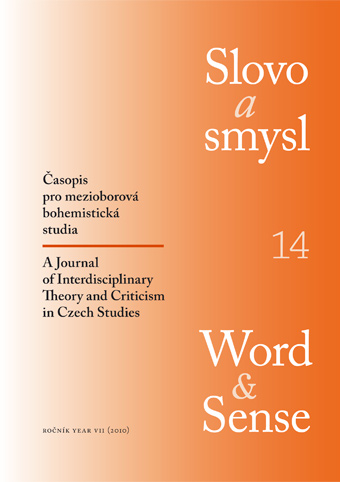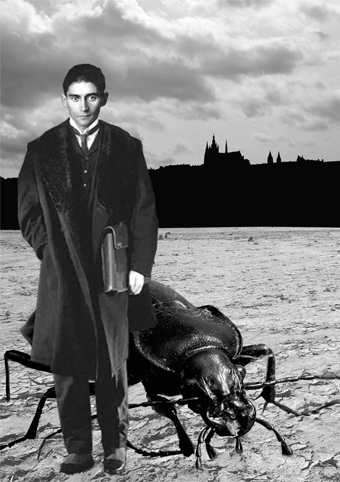Jiří Karásek ze Lvovic
If there is such a thing as a collective consciousness, then its Czech version would certainly label the works of Jiří Karásek ze Lvovic (1871–1951) as decadence. Although deeply rooted in a European context, Czech decadence represented its own specific interpretation closely related to a general spiritual and political crisis in Czech society at the end of the 19th century. In literature, the new impulses collided with older Parnassian aesthetics and caused tumultuous generational conflicts whose one consequence was the birth of Moderní revue (Modern Revue, 1894–1925), a literary journal on symbolism and decadence. The journal accentuated values traditionally associated with decadence, such as exclusive individualism, aestheticism and amorality, and gathered a considerable number of young revolting authors. Jiří Karásek, at that point not yet “ze Lvovic”, was the journal’s co‑founder and co‑editor.
Czech readers of the time were familiar with Karásek mainly as an intransigent critic since literary criticism had come to be the main battlefield for literary dominance in the 1890s. Some may have known his first novel published in book form, Bezcestí (A Roadless Place, 1893), although this somewhat delayed manifestation of Karásek’s beginnings in naturalism passed relatively unnoticed. It was seemingly long forgotten already in 1894 when Karásek published the first of four books of poetry which Czech literary history considers provocatively decadent: Zazděná okna (Bricked‑Up Windows, 1894), Sodoma (1895), Kniha aristokratická (The Aristocratic Book, 1896), and Sexus necans (1897). From an atmosphere of unfulfilled yearning, solitude and death, each collection became still more provocative due to a gradually stronger individual and aristocratic stylization, where Catholicism, paganism and homoeroticism were frequent motifs. In fact, Sodoma was confiscated by the police even before reaching the public because of its homoerotic imagery._1
Karásek’s poetry and prose were closely related aesthetically. In the 1890s, he published several novellas. Stojaté vody (Stagnant Waters, 1895) was one of them. A melancholic author wanders about in Prague, a city as dead and rotting as his own personality. He dreams of writing and creating but is captured in stagnation and absorbed in thoughts that constantly lead to feelings of emptiness, indecision, and indolence. As such, Stojaté vody represents typical features of Karásek’s prose from the 1890s. It presents lyrical analyses of mental states, where the storyline is weakened to a minimum and the soul takes on the nature of an acting subject. These motifs also characterize his novel Gotická duše (A Gothic Soul, 1900) perceived by Karásek’s contemporaries as programmatically decadent and often seen as the culmination of his decadent prose. Here, the last degenerated member of a noble family also wanders about in Prague and tries to cope with the meaninglessness of his life. His mental journey ends, however, in madness.
The beginning of the 20th century was generally a period of conciliation in Czech literature, when challenges raised in the literature of the 1890s were met with different strategies and solutions._2 At this point, changes appeared also in Karásek’s aesthetics. He restrained the decadent gestures and began creating subjective worlds “of dream and fiction”._3 The former meaninglessness was replaced by an alternative, timeless sphere transcending the narrow horizons of reality. From now on, his texts were marked with neo‑romanticism and features of gothic prose, and their storylines were considerably strengthened.
The change in Karásek’s aesthetics was accompanied by a revision of his work as well as an alternation in his own identity. From 1902, his collected works were being published. Karásek saw this circumstance as an opportunity to select only those texts which he considered to represent his genuine expression. He thus dismissed several texts from the 1890s, among them Stojaté vody. Moreover, he changed his name from the ordinary‑sounding “Jiří Karásek” to “Jiří Karásek ze Lvovic”, where the last part, “ze Lvovic”, was a mark of nobility. The diference between his literary stylization and his self‑stylization, well‑known to his contemporaries, thus more or less disappeared.
The relation between reality and fiction represented a recurrent topic in Karásek’s writings. He was considerably inspired by Oscar Wilde’s “philosophy of lying” and saw “lying” as an essential value in art as a means of transcendence. The negation of the positivist “truth” by means of “lying” made the literary text a space for realizing the impossible. In this light, the systematic presence of homoerotic motifs in Karásek’s texts could be understood not only as elements in a decadent repertoire, but as bearers of specific meaning._4 It is symptomatic that one of the products of Karásek’s changed aesthetics was homoerotic triangle dramas set in a timeless vacuum, where the decadent repertoire represented a background; Román Manfreda Macmillena (Manfred Macmillen’s Novel, 1907) and Scarabaeus (The Scarab, 1908). These novels were the two first volumes of what was to become the trilogy Romány tří mágů (The Novels of the Three Magicians), whose last part, Ganymedes (Ganymede), was published as late as 1925.
Legends represent another expression of Karásek’s changed aesthetics, less explored by literary historians. Karásek interpreted and re‑actualized old Christian legends. Keeping to the idea of “lying”, he ignored their acknowledged versions and insisted that history must be considered pure material and by no means an artist’s manacles._5 His method was obviously inspired by Julius Zeyer (1841–1901), one of the inspiration sources and predecessors of Czech decadence,_6 who likewise wrote what he called “renewed images” exploiting legendary material.
Karásek’s first collection of legends was titled Posvátné ohně (Holy Fires, 1911) and contained both Smrt Salomina (The Death of Salomé) and Růže svatého Šebestiána (The Roses of St. Sebastian). In the legends, religious and mystical motifs were combined with strong aestheticism, even in scenes of torture and death. Karásek continued to write legends now and then until the 1920s, when a new change appeared in his aestehtics.
After the death of Karásek’s close friend Arnošt Procházka, who had been the main editor of Moderní revue, the journal ceased to exist in 1925. Karásek now slid into a state of isolation, both in literature and personal life, and this isolation eventually made him approach reality. A kind of “nostalgic realism” characterized his book of poetry Písně tulákovy o životě a smrti (A Vagabond’s Songs of Life and Death, 1930), and a similar trend could be observed both in his autobiographical novel Ztracený ráj (Paradis Lost, 1938) and in his last book of poetry, Poslední vinobraní (The Last Vintage, 1946). However, his last published text, Zlověstná madona (The Omnious Madonna, 1947), returned to the mysterious dimensions of his neo‑romantic texts.
In spite of changes in aesthetics, Karásek never fully parted with the repertoire and style of decadence. As late as in the 1930s, Karásek talked of the “miraculous vitality and persistence of those who had been criticized for morbidity, perversity, pathology, in other words: decadence”._7 There is a decadent continuum in his work and Karásek remains, not at all without reason, the decadent par excellence of Czech literature.
NOTES
_1
Roar Lishaugen: Speaking with a Forked Tongue. Double Reading Strategies in Romány tří mágů by Jiří Karásek ze Lvovic. University of Gothenburg, Gothenburg 2008.
_2
Daniel Vojtěch: Vášeň a ideál. Na křižovatkách moderny. Academia, Prague 2008.
_3
Jiří Karásek ze Lvovic. Chimérické výpravy. Hugo Kosterka, Prague 1906.
_4
Lishaugen: Speaking with a Forked Tongue.
_5
Jiří Karásek ze Lvovic: Král Rudolf v historii a v básnické fikci. Moderní revue, vol. 33, no. 3, May 1918, pp. 133–138.
_6
Robert B. Pynsent: Julius Zeyer. The Path to Decadence. Mouton, The Hague 1973; idem: Czech Decadence. In: Marcel Cornis‑Pope and John Neubauer (eds.): History of the Literary Culture of East‑Central Europe. Virginia Commonwealth University – University of Amsterdam, 2004, pp. 348–363.
_7
Jiří Karásek ze Lvovic: Jubileum českého symbolismu. Lumír, vol. 63, no. 1, 5. 11. 1936, pp. 6–9.


